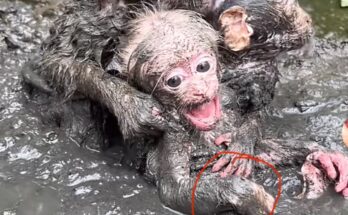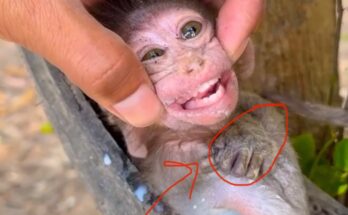Wildlife rescue and rehabilitation often demand both compassion and precision—especially when caring for an injured primate. A severely injured monkey’s leg requires immediate attention to reduce the risk of infection and to promote healing. Whether you’re a wildlife volunteer, a vet assistant, or simply someone who’s found an injured monkey in distress, knowing how to properly clean and wash the wound can make a critical difference.
Disclaimer: Always consult a licensed wildlife veterinarian if possible. Handling wild animals can be dangerous and should only be done with appropriate training and protective measures.
1. Ensure Safety First
Before approaching the injured monkey, assess the situation. Even an injured monkey can bite or scratch out of fear or pain. Wear thick gloves, use a towel or soft net to gently restrain the animal, and never attempt care without someone trained in wildlife handling.
If the monkey is unconscious or immobile, you may proceed carefully, but keep movement minimal to avoid further injury.
2. Prepare a Clean Area and Supplies
Before washing the wound, prepare a clean workspace with the following supplies:
- Sterile saline solution or clean boiled-and-cooled water
- Antiseptic (e.g., diluted Betadine or chlorhexidine)
- Sterile gauze pads
- Non-stick wound dressings
- Tweezers and scissors (sterilized)
- Clean towel or blanket
- Mild sedative (only if under vet guidance)
- Veterinary-approved pain relief (if available)
3. Gently Clean the Wound
Start by rinsing the injured leg with sterile saline to remove visible dirt and debris. If the monkey is conscious and stressed, this step may require sedation or restraint by a trained professional.
Use sterilized tweezers to gently remove any gravel, leaves, or other particles embedded in the wound. Then, gently wash the leg with a mild antiseptic solution using gauze pads. Avoid scrubbing hard; this can damage tissue and delay healing.
4. Assess the Severity
Once the area is clean, evaluate the injury. Is it a deep laceration, a puncture, or a bone fracture? Is there active bleeding or signs of infection like pus or foul odor? If the injury appears beyond surface-level, stop and seek immediate veterinary care.
For deep or compound wounds, suturing and antibiotics may be necessary, which are not tasks for untrained individuals.
5. Dress the Wound
Apply a non-stick sterile dressing to the cleaned wound, and wrap it gently with a bandage to keep it in place. Ensure the wrap isn’t too tight, as it can cut off circulation. Change the dressing daily or more often if it becomes wet or soiled.
6. Monitor and Transport
A severely injured monkey should be monitored for signs of infection—swelling, fever, pus, or behavioral changes. Transport the monkey to a licensed wildlife rehabilitation center or veterinarian as soon as possible for further treatment and recovery support.
Final Thoughts
Caring for an injured monkey is not just about cleaning wounds—it’s about providing humane, professional care that gives the animal a chance at survival and reintegration into the wild. Always prioritize safety, cleanliness, and expert guidance. Your intervention could be the first step in saving a life.



